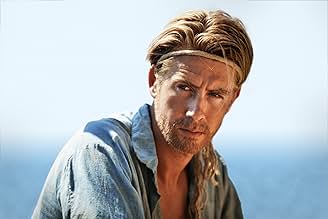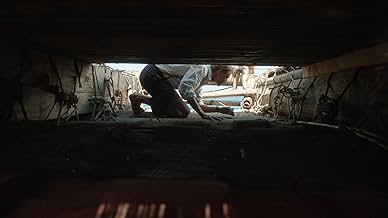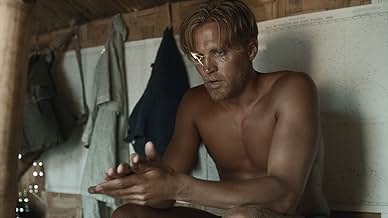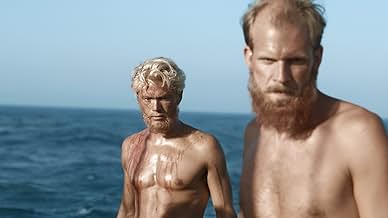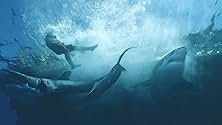Die epische 6.900 Kilometer lange Reise, die der legendäre Entdecker Thor Heyerdal 1947 auf einem Floß aus Balsaholz quer über den Pazifik unternahm, um nachzuweisen, dass es für die südamer... Alles lesenDie epische 6.900 Kilometer lange Reise, die der legendäre Entdecker Thor Heyerdal 1947 auf einem Floß aus Balsaholz quer über den Pazifik unternahm, um nachzuweisen, dass es für die südamerikanischen Ureinwohner in der Zeit vor Kolumbus möglich war, Polynesien zu besiedeln.Die epische 6.900 Kilometer lange Reise, die der legendäre Entdecker Thor Heyerdal 1947 auf einem Floß aus Balsaholz quer über den Pazifik unternahm, um nachzuweisen, dass es für die südamerikanischen Ureinwohner in der Zeit vor Kolumbus möglich war, Polynesien zu besiedeln.
- Regie
- Drehbuch
- Hauptbesetzung
- Für 1 Oscar nominiert
- 12 Gewinne & 14 Nominierungen insgesamt
- Thor Heyerdahl
- (as Pål Hagen)
- Herman Watzinger
- (as Anders Baasmo Christiansen)
- Thor 6 yrs.
- (as Kasper Ameberg Johnsen)
Empfohlene Bewertungen
Awesome retelling about the dangerous adventure starred by Thor and a valiant group of heroes . Big budget production with gorgeous scenarios , colorful images , thrills , emotion and sense of style . Large parts of the film were filmed in two versions at the same time, one in Norwegian, the other in English, in order to secure international funding. Including wide participation from several nations , as there take part Sweden, Bulgaria , Norway , Malta , Maldives crews . Glamorous and glimmer cinematography by Geir Hartly Andreassen . Special mention to sensitive as well as evocative original Music by Johan Söderqvist . Lavishly produced among several countries such as UK | Norway | Denmark | Germany | Sweden with important financing by great producer Jeremy Thomas . The film's producer, Jeremy Thomas, had wanted to make the film since 1996 and was granted the rights to the story by Thor Heyerdahl before the latter's death in 2002 . The motion picture was compellingly directed by Joachim Rønning (Bandidas , Max Manus) and Espen Sandberg and it was the official submission of Norway to the Best Foreign Language Film of the 85th Academy Awards 2013.
The film was well based on real events , these are the followings : Kon-Tiki was the raft used by Norwegian explorer and writer Thor Heyerdahl in his 1947 expedition across the Pacific Ocean from South America to the Polynesian islands. It was named after the Inca sun god, Viracocha, for whom "Kon-Tiki" was said to be an old name. Kon-Tiki is also the name of Heyerdahl's book; the Academy Award-winning documentary film chronicling his adventures; and the 2012 dramatised feature film nominated for the Academy Award for Best Foreign Language Film.Heyerdahl believed that people from South America could have settled Polynesia in pre-Columbian times. Although most anthropologists as of 2010 had come to the conclusion they did not, in 2011, new genetic evidence was uncovered by Erik Thorsby that Easter Island inhabitants do have some South American DNA, lending credence to at least some of Heyerdahl's theses. His aim in mounting the Kon-Tiki expedition was to show, by using only the materials and technologies available to those people at the time, that there were no technical reasons to prevent them from having done so. Although the expedition carried some modern equipment, such as a radio, watches, charts, sextant, and metal knives, Heyerdahl argued they were incidental to the purpose of proving that the raft itself could make the journey.The Kon-Tiki expedition was funded by private loans, along with donations of equipment from the United States Army. Heyerdahl and a small team went to Peru, where, with the help of dockyard facilities provided by the Peruvian authorities, they constructed the raft out of balsa logs and other native materials in an indigenous style as recorded in illustrations by Spanish conquerers. The trip began on April 28, 1947. Heyerdahl and five companions sailed the raft for 101 days over 6900 km (4,300 miles) across the Pacific Ocean before smashing into a reef at Raroia in the Tuamotu Islands on August 7, 1947. The crew made successful landfall and all returned safely.Thor Heyerdahl's book about his experience became a bestseller. It was published in Norwegian in 1948 as The Kon-Tiki Expedition: By Raft Across the South Seas, later reprinted as Kon-Tiki: Across the Pacific in a Raft. It appeared with great success in English in 1950, also in many other languages. A documentary motion picture about the expedition, also called Kon-Tiki was produced from a write-up and expansion of the crew's filmstrip notes and won an Academy Award in 1951. It was directed by Thor Heyerdahl and edited by Olle Nordemar. The voyage was also chronicled in the documentary TV-series The Kon-Tiki Man: The Life and Adventures of Thor Heyerdahl, directed by Bengt Jonson.The original Kon-Tiki raft is now on display in the Kon-Tiki Museum in Oslo.
The film began with Thor as a child when he fell into the icy lake and almost drowned. However we later find out that that accident and his inability to swim did not deter his adventurous spirit. We fast forward to Thor and his wife Liv on Fatu Hiva, a Polynesian island, in 1937. There he learned the belief of the islanders that their ancestor Tiki actually came from the East (the Americas) instead of Asia as commonly assumed.
For several years, Thor tried to get his theory about Polynesian origins published but was repeatedly rejected. Therefore, he resolved to prove his theory by recreating Tiki's original ocean journey from Peru to Polynesia on a raft made of balsa wood (with strictly no modern materials).
It is just too coincidental that I am watching another ocean adventure just a few days after watching "Life of Pi." Kon-Tiki traveled the Pacific in the opposite direction that Pi did. It had an experienced though spare crew of 5, composed of two sailors, an engineer, an ethnographer and Thor, so it had a distinct advantage over the teenager and a tiger.
But maybe because I just watched Pi, maybe I expected to see so much more maritime misfortune than I did with Kon-Tiki. However, that sequence with vicious sharks had real heart-stopping suspense. I do have some misgivings about that episode with the whale shark, because it is not really the aggressive creature depicted in the film.
This was a straight-forward adventure film for the family. It may seem old-fashioned to some, nothing too controversial or strange as one can expect from modern European cinema. It was by no means boring, but I admit I felt like it lacked a certain edge while I was watching it. The crew members did not even have any significant conflict among each other and they were trapped on a raft for a hundred days! That may come across as unbelievable in these days of Big Brother and other "reality" TV shows.
I do hope I can find myself a copy of the 1950 Oscar-winning documentary about the real Thor Heyerdahl, his crew and their 101-day oceanic ordeal. That should be very interesting indeed.
Anyway, even though I have not watched nor have any knowledge of the original, I am impressed with the way this film was made. It was pretty well-balanced with no major flaws in my opinion. Well acting performances by the cast were complemented by a high level of cinematography technique that made looked like the entire journey on the raft was really shot wide in the ocean. Like Life of Pi, there were certain marine animals that were infamously being shown from the real life account of Kon-Tiki, and the CGI made on the animals were so real you probably cant tell if those animals were fake.
Probably the major point of improvement that the film can work on is the lack of character development of the other participants in the Kon Tiki, aside from Thor Heyerdahl himself. I am not implying there was none, as we get to see Thor's mates conflicts happening from the start till the end, but I wish I could have known more why they decided to join and their background story. Understandably, with the time given the film had chosen to focus on Thor instead with a lot of plot material explaining why he had to venture into such a journey.
I was also curious if there were more that could be shown about a group of men enduring a raft journey across the ocean in +100 days. But overall, just by solely comparing the similarities, this is much better and believable than Life of Pi as well as a very satisfying movie experience.
Beautiful cinematography...including magnificent scenes of whales & sharks circling the raft.
Character studies of Thor Heyerdahl & his companions on the journey are intelligent subtle portrayals. Thor is one driven man, from almost drowning in childhood to landing on the beach on Roraia, Indonesia. Thor spent ten years with his theory that Polynesia was settled from Peru; not from Asia, the settled hypothesis at the time. Final proof came via the 1947 voyage on a raft using the same 1500 year old techniques of navigation and raft construction. While this may sound a bit dry, it is not. The passion of the participants is palpable. Each has their own reason for going on the journey; most simply falling under Heyerdahl's charisma. (Heyerdahl's 1950 documentary won the Academy Award, and remains the only Norwegian winner of an Academy Award to date.)
Though not cast based simply on physical looks (per the co-directors), several are magnificent specimens of blond 1940s fit men...and their bonding.
Every scene was filmed first in Norwegian, then in English; (US release of the English version seen is expected by the Weinstein group later in 2013.) Filming was 59 days in six countries. Audience reaction of the PSIFF screening was loudly appreciated followed with Q&A with the co-directors.
During the 20th century some individual achievements so captured the popular attention as to become iconic: Lindberg's flight across the Atlantic, Hillary and Norgay's conquest of Everest, Roger Bannister's four minute mile. Thor Heyerdahl's 1947 voyage across the Pacific was one of these events. His book, Kon-Tiki, sold tens of millions of copies, and his 1950 documentary won an Academy Award, as much a recognition of the feat as the film.
Norwegian directors Joachim Rønning and Espen Sandberg have now decided to put on the screen a dramatized account of Heyerdahl's expedition. But the obvious question is how can you make interesting the story of six men confined to a small wooden raft for 101 days? In fact by comparison to the exploit it recorded, the original documentary came across as rather bland, precisely because of such limitations. But this new film is anything but tame, and succeeds in combining striking photography of the adventure itself with a compelling look at one man's quest to show that "it can be done."
The strength of the picture is that it situates the voyage within the context of Heyerdahl's struggle to get the scientific and financial support to try out his theories. He had speculated that Polynesia was settled by Inca voyagers who had used the prevailing currents to drift across the Pacific on rafts similar to the one he would build. (He proved this possible, although DNA testing suggests that Polynesians share a predominantly Asian heritage.)
Heyerdahl had developed this premise much earlier, but after World War II, he made serious attempts to secure the backing for a voyage that would test his theories. Not only did he encounter opposition from those who felt that he was wrong, but even more often he was dismissed as a fanatic with a suicidal plan.
Eventually he did manage to scrounge some backing, including private loans, help from the Peruvian authorities and supplies from the U.S. Navy. Perhaps more importantly, he found five companions who had confidence enough to put their lives in his hands. All were Norwegian except Bengt Danielsson, a Swede with an interest in migration. Erik Hesselberg was the navigator. Knut Haugland and Torstein Raaby, both heroes of the Norwegian resistance, were the radio experts. Herman Watzinger was an engineer who helped design the raft, and who recorded much of the voyage's scientific data.
Although he took along modern equipment, Heyerdahl was concerned that the raft itself should be constructed only from materials that were available in ancient times. Accordingly the raft was constructed from logs tied together with rope, surmounted by a thatched cabin and a large cloth sail. The raft itself was about 45 by 18 feet (13.7 by 5.5 m), and the cabin about 14 by 8 (4.2 by 2.4 m). The crew sailed from Callao, Peru, on April 28, 1947 and arrived in Raroia in the Tuamotu Islands on August 7.
The film succeeds by contextualizing these 101 days at sea against Heyerdahl's struggles to get the expedition underway. Although the inevitable storm and the equally foreseeable shark attack have their moments, the movie similarly attends to the relationships among the expedition's six members, their level of bonding to Heyerdahl as leader, and his own relationship with a wife who wanted to be supportive, but who found the risks unacceptable. It establishes the overall context by its early sequence dealing with Thor's honeymoon stay in the Marquesas, where he began to discover the apparent Inca connections that led to his theories.
In the central role of Thor Heyerdahl, Pål Sverre Valheim Hagen must carry the story, and he does. His re-creation of the historical character is convincing as the embodiment of determination, not quite obsessive but coming close, as he plans, argues and cajoles to try to turn his project into a reality. As his fellow Norwegian crew members Odd Magnus Williamson as Hesselberg, Tobias Santlemann as Haugland, and Jacob Oftebro as Raaby are equally credible figures: young, heroic, and willing to give Heyerdahl their trust. Playing the only non-Norwegian in the group, Gustaf Skarsgård as Bengt Danielsson is a little detached, but perhaps even more intellectually committed than the others to what they are about. For contrast and drama, the filmmakers apparently took liberties with the character of Herman Watzinger, played by Anders Baasmo Christensen. Christensen does well with the part given him, although the real-life Watzinger was almost certainly stronger and more competent than the movie shows him. Given that she must play an ambivalent role, Agnes Kittelsen as Liv gives a very effective performance as Thor's wife and the film's only prominent female character.
Gorgeous photography and great production values set Kon-Tiki off. The Pacific Ocean scenes were actually shot in the waters off Malta, the tropical ones in the Maldives and Thailand, with other locations in Norway and the U.S. used as appropriate. It is a real accomplishment that even with the limited space of the raft cinematographer Geir Hartly Andreassen never lets it become visually boring. Going from the micro to the macro, he manages to keep interesting also the vast empty spaces of the ocean, which emerges as a living character in its own right, often peaceful, sometimes petrifying, always powerful.
It must have been a temptation for the directors and principal screenwriter Petter Skavlan to fictionalize Heyerdahl's exploits and to create a stunning action/adventure tale on the lines of A Perfect Storm or White Squall. Thankfully they recognized that Heyerdahl himself was a character larger than life whose daring voyage became an extension of himself and his ambitions. In doing that they keep alive the iconic figure that he was, and give audiences some appreciation of how the sheer willpower of one individual can produce deeds that capture the imagination of the world.
Wusstest du schon
- WissenswertesLarge parts of the film were filmed in two versions at the same time, one in Norwegian, the other in English, in order to secure international funding. See ALTERNATE VERSIONS section for greater detail.
- PatzerThe crew were not worried about whether the ropes would hold the float together, as it is portrayed in the film. As we can see in the Kon-Tiki (1950) documentary, the balsa wood was much softer than the rope, and it was actually the rope that ate through the wood. The result was that the rope eventually was protected by the space that had been created around it.
- Zitate
Epilogue: Bengt fell in love with Polynesia. He settled there and became a Consul General of Sweden. He died in 1997.
Epilogue: Erik built himself a sailboat, that became his home for 11 years. He worked as an artist until his death in 1972.
Epilogue: Torstein kept going on expeditions. He died in 1964 during an attempt to reach the North Pole on skis.
Epilogue: Knut resumed his career in military intelligence. He was also instrumental in the establishment of the Kon-Tiki museum. He died the Christmas of 2009.
Epilogue: Herman became the director of UN's Food and Agriculture organization. He died at Titica lake in 1986.
Epilogue: Thor wrote a book about Kon-Tiki. It was translated to over 70 languages, and sold over 50 million copies. The documentary about the expedition won an Oscar. Liv and Thor divorced after the Kon-Tiki expedition. Their boys lived with Liv, who later moved to the US where she died in 1969. Thor continued his work as an experimental archaeologist, author and explorer. He died in 2002.
- Crazy CreditsBefore the closing credits, short clips are shown in which original footage shot by Heyerdahl was reenacted by the "Kon-Tiki" actors: urinating overboard in the open sea, dancing with natives under palms, portraits, and the like. Along with this, brief notes concerning each crew member's path of life after the trip are given.
- Alternative VersionenIn an unusual technique, the film was shot simultaneously in both Norwegian and English, with each scene being filmed twice, first in Norwegian and then in English, with the same actors. This resulted in two versions of the film to be released, one primarily for the Norwegian domestic market, the other for an international audience. In a few cases, such as action scenes and computer-generated sequences, they used the same shot, later adding English with dubbing.
- VerbindungenFeatured in 70th Golden Globe Awards (2013)
- SoundtracksFlickan i Havanna
("The girl in Havana")
Lyrics by Evert Taube (as Taube) and music by Horatio R. Palmer (as Palmer)
Top-Auswahl
Details
- Erscheinungsdatum
- Herkunftsländer
- Offizielle Standorte
- Sprachen
- Auch bekannt als
- Thor Heyerdahls Kon Tiki
- Drehorte
- Nu Boyana Film Studios, Sofia, Bulgarien(New York exterior scenes)
- Produktionsfirmen
- Weitere beteiligte Unternehmen bei IMDbPro anzeigen
Box Office
- Budget
- 16.600.000 $ (geschätzt)
- Bruttoertrag in den USA und Kanada
- 1.517.410 $
- Eröffnungswochenende in den USA und in Kanada
- 22.168 $
- 28. Apr. 2013
- Weltweiter Bruttoertrag
- 22.842.887 $
- Laufzeit1 Stunde 58 Minuten
- Farbe
- Sound-Mix
- Seitenverhältnis
- 2.35 : 1
Zu dieser Seite beitragen






